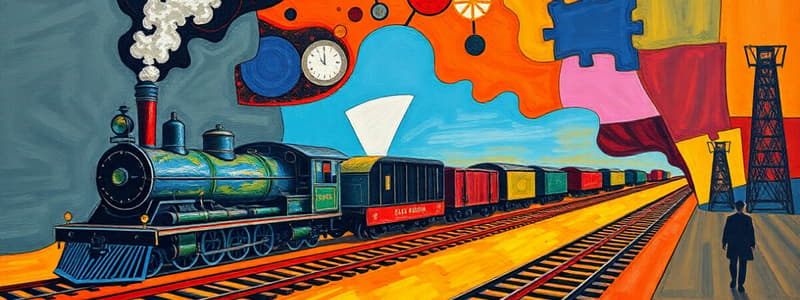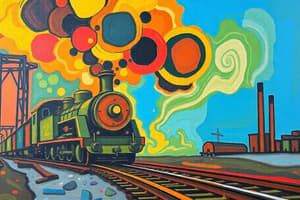Podcast
Questions and Answers
What significant technological advancements occurred in the late 1800s?
What significant technological advancements occurred in the late 1800s?
The late 1800s witnessed significant technological advancements, especially in the steel industry. These advancements were driven by innovations such as the Bessemer process, which allowed for mass production of steel, leading to lower costs and increased availability. Furthermore, the introduction of machinery across various industries led to a shift in labor dynamics, with many workers displaced by automation. Key figures like Thomas Edison contributed to this technological progress with inventions such as the light bulb, which revolutionized energy consumption.
What was the impact of the expansion of railroads across the United States?
What was the impact of the expansion of railroads across the United States?
The expansion of railroads across the United States resulted in the rapid growth of cities, which evolved into hubs of commerce and trade. Railroads facilitated the transportation of raw materials and finished goods, boosting the economy and creating jobs. This increased connectivity also led to a rise in suburban living as people could commute to urban centers for work. Railroads played a crucial role in the westward expansion, influencing settlement patterns and the development of new territories.
Describe vertical integration as a business strategy.
Describe vertical integration as a business strategy.
Vertical integration involves controlling all aspects of production, from raw materials to final product distribution. This strategy aims to reduce costs and control the supply chain. A prime example of vertical integration is Andrew Carnegie's steel operations, where he owned mines, mills, and distribution channels.
Explain horizontal integration as a business strategy and provide an example.
Explain horizontal integration as a business strategy and provide an example.
What were the primary criticisms leveled against monopolies?
What were the primary criticisms leveled against monopolies?
The Sherman Antitrust Act of 1890 aimed to promote monopolistic practices.
The Sherman Antitrust Act of 1890 aimed to promote monopolistic practices.
What was the primary reason for the rise of labor unions in the late 19th century?
What was the primary reason for the rise of labor unions in the late 19th century?
What were the main factors that drove imperialism in the late 19th and early 20th centuries?
What were the main factors that drove imperialism in the late 19th and early 20th centuries?
Describe the impact of the explosion of the USS Maine.
Describe the impact of the explosion of the USS Maine.
What was the significance of the Panama Canal?
What was the significance of the Panama Canal?
What were the primary causes of World War I?
What were the primary causes of World War I?
Explain trench warfare and its impact on World War I.
Explain trench warfare and its impact on World War I.
Which of the following were key events during World War I?
Which of the following were key events during World War I?
What was the impact of the Espionage and Sedition Acts on American society during World War I?
What was the impact of the Espionage and Sedition Acts on American society during World War I?
What was the impact of women's role in the workforce during World War I?
What was the impact of women's role in the workforce during World War I?
How did propaganda impact public sentiment about World War I?
How did propaganda impact public sentiment about World War I?
What were some of the hardships faced by soldiers during World War I?
What were some of the hardships faced by soldiers during World War I?
Describe the impact of the psychological toll of warfare on soldiers during World War I.
Describe the impact of the psychological toll of warfare on soldiers during World War I.
What is Theodore Roosevelt known for?
What is Theodore Roosevelt known for?
How did the rise of monopolies impact the American economy?
How did the rise of monopolies impact the American economy?
What was the immediate catalyst for World War I?
What was the immediate catalyst for World War I?
Who initially advocated for neutrality before leading the United States into World War I?
Who initially advocated for neutrality before leading the United States into World War I?
The Schlieffen Plan aimed for a quick victory over Russia before turning to France.
The Schlieffen Plan aimed for a quick victory over Russia before turning to France.
What was the significance of the Zimmermann Note?
What was the significance of the Zimmermann Note?
How did the Selective Service Act impact the United States' involvement in World War I?
How did the Selective Service Act impact the United States' involvement in World War I?
What was the main purpose of the Open Door Policy?
What was the main purpose of the Open Door Policy?
What did the Sherman Antitrust Act aim to prevent?
What did the Sherman Antitrust Act aim to prevent?
What is the primary message conveyed in the quote attributed to President Woodrow Wilson?
What is the primary message conveyed in the quote attributed to President Woodrow Wilson?
What is the significance of the assassination of Archduke Franz Ferdinand?
What is the significance of the assassination of Archduke Franz Ferdinand?
What was the impact of the sinking of the Lusitania on public opinion in the United States?
What was the impact of the sinking of the Lusitania on public opinion in the United States?
How did militarism and imperialism contribute to the outbreak of World War I?
How did militarism and imperialism contribute to the outbreak of World War I?
Flashcards
Bessemer process
Bessemer process
This process allowed for the mass production of steel, leading to lower costs and increased availability.
Light bulb
Light bulb
This invention changed the way we used energy, making it possible to work at night and transforming industries.
Cities
Cities
The rapid growth of railroads across the US led to the rise of these centers of commerce and trade.
Suburbs
Suburbs
Signup and view all the flashcards
Vertical integration
Vertical integration
Signup and view all the flashcards
Horizontal integration
Horizontal integration
Signup and view all the flashcards
Monopoly
Monopoly
Signup and view all the flashcards
Monopolistic practices
Monopolistic practices
Signup and view all the flashcards
Labor unions
Labor unions
Signup and view all the flashcards
Samuel Gompers
Samuel Gompers
Signup and view all the flashcards
Labor and management
Labor and management
Signup and view all the flashcards
Labor strikes
Labor strikes
Signup and view all the flashcards
Imperialism
Imperialism
Signup and view all the flashcards
Explosion of the USS Maine
Explosion of the USS Maine
Signup and view all the flashcards
Open Door Policy
Open Door Policy
Signup and view all the flashcards
Spanish-American War
Spanish-American War
Signup and view all the flashcards
Boxer Rebellion
Boxer Rebellion
Signup and view all the flashcards
Andrew Carnegie
Andrew Carnegie
Signup and view all the flashcards
Alexander Graham Bell
Alexander Graham Bell
Signup and view all the flashcards
Homestead Strike
Homestead Strike
Signup and view all the flashcards
Sherman Antitrust Act
Sherman Antitrust Act
Signup and view all the flashcards
Archduke Franz Ferdinand
Archduke Franz Ferdinand
Signup and view all the flashcards
Woodrow Wilson
Woodrow Wilson
Signup and view all the flashcards
Count Alfred von Schlieffen
Count Alfred von Schlieffen
Signup and view all the flashcards
Militarism
Militarism
Signup and view all the flashcards
Nationalism
Nationalism
Signup and view all the flashcards
Imperialism
Imperialism
Signup and view all the flashcards
Allies
Allies
Signup and view all the flashcards
Central Powers
Central Powers
Signup and view all the flashcards
Trench warfare
Trench warfare
Signup and view all the flashcards
Sinking of the Lusitania
Sinking of the Lusitania
Signup and view all the flashcards
Zimmermann Note
Zimmermann Note
Signup and view all the flashcards
Selective Service Act
Selective Service Act
Signup and view all the flashcards
Study Notes
Key Innovations in the Late 1800s
- Technological advancements, particularly in the steel industry, significantly increased productivity and efficiency.
- The Bessemer process enabled mass steel production, lowering costs and increasing availability.
- Mechanization led to displacement of workers in many industries.
- Thomas Edison's inventions, like the light bulb, revolutionized energy consumption.
- Railroads significantly expanded, enabling the transport of goods and people, contributing to urban growth.
Impact of Railroads on Society
- Railroad expansion across the US led to rapid city growth due to trade and commerce.
- Railroads boosted the economy and created jobs, facilitating the transport of raw materials and finished goods.
- Increased connectivity resulted in suburban living as people commuted to urban centers.
- Railroads played a key role in westward expansion, influencing settlement patterns and territory development.
- Competition among railroad companies sparked price wars, benefiting consumers but harming smaller businesses.
Business Practices and Economic Strategies
- Vertical Integration: Controlling all aspects of production (raw materials to final distribution), exemplified by Andrew Carnegie's steel operations.
- Horizontal Integration: Merging with competitors to enhance market share. John D. Rockefeller used this strategy in the oil industry.
- Both strategies were aimed at cost reduction and efficiency enhancement but raised concerns about monopolistic practices.
- Case studies include Carnegie Steel and Standard Oil, which dominated industries through these practices.
- Monopolies were criticized for raising prices, reducing goods quality, and eliminating competition.
- Political influence of monopolistic corporations concerned governments.
- The Sherman Antitrust Act of 1890 was enacted to combat monopolistic practices and corporate power.
- Public sentiment against monopolies was supported by labor movements and worker rights advocacy.
Labor Movements and Social Change
- Samuel Gompers emphasized the importance of labor organization in advocating for workers' rights in 1894.
- The rise of labor unions in the late 19th century responded to poor working conditions and meager wages.
- Strikes, like the Homestead and Pullman strikes, highlighted tensions between labor and management, often leading to government intervention.
- Unions aimed to negotiate better wages, hours, and working conditions.
- Labor disputes saw governments often side with business owners and used troops to break up strikes.
- Public perception of labor strikes gradually shifted towards increasing sympathy for worker rights.
Imperialism and Global Expansion
- Late 19th/early 20th centuries experienced a surge in imperialism, driven by the need for raw materials and markets.
- Nationalistic rivalry among European powers fuelled competition for global colonies.
- The Boxer Rebellion in China exemplified resistance against foreign intervention and imperialism.
- The Open Door Policy aimed for equal trading rights in China, demonstrating US economic interests in Asian markets.
- Annexation of Hawaii was motivated by economic interests (particularly sugar production).
- The Spanish-American War reflected a significant shift towards US imperialism.
Key People
- Thomas Edison: Inventor of the light bulb.
- Alexander Graham Bell: Inventor of the telephone.
- Andrew Carnegie: Industrialist, a major proponent of vertical integration.
- Theodore Roosevelt: US President who led the country during the Spanish-American War.
- Samuel Gompers: Key figure in the development of American labor unions.
- Woodrow Wilson: 28th US President who led the country during WWI.
- Archduke Franz Ferdinand: His assassination triggered WWI.
- Alfred von Schlieffen: Developed the Schlieffen Plan.
World War I
- Militarism, nationalism, imperialism and alliances fostered a tense Europe.
- The assassination of Archduke Franz Ferdinand sparked WWI.
- The sinking of the Lusitania and the Zimmerman Note contributed to the US entry.
- Trench warfare characterized the fighting on the Western Front.
- Significant incidents like the Lusitania sinking and the Zimmerman note increased public sentiment against Germany, and influenced the Allied powers.
- Selective Service Act, enacted in 1917, required men to register for the draft.
- Espionage and Sedition Acts curtailed free speech to support wartime efforts.
- The war significantly impacted American society, influencing literature, art, and public opinion.
Studying That Suits You
Use AI to generate personalized quizzes and flashcards to suit your learning preferences.




